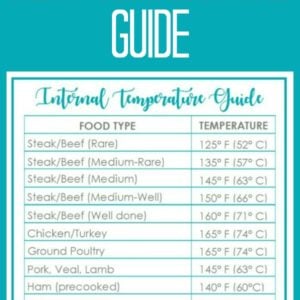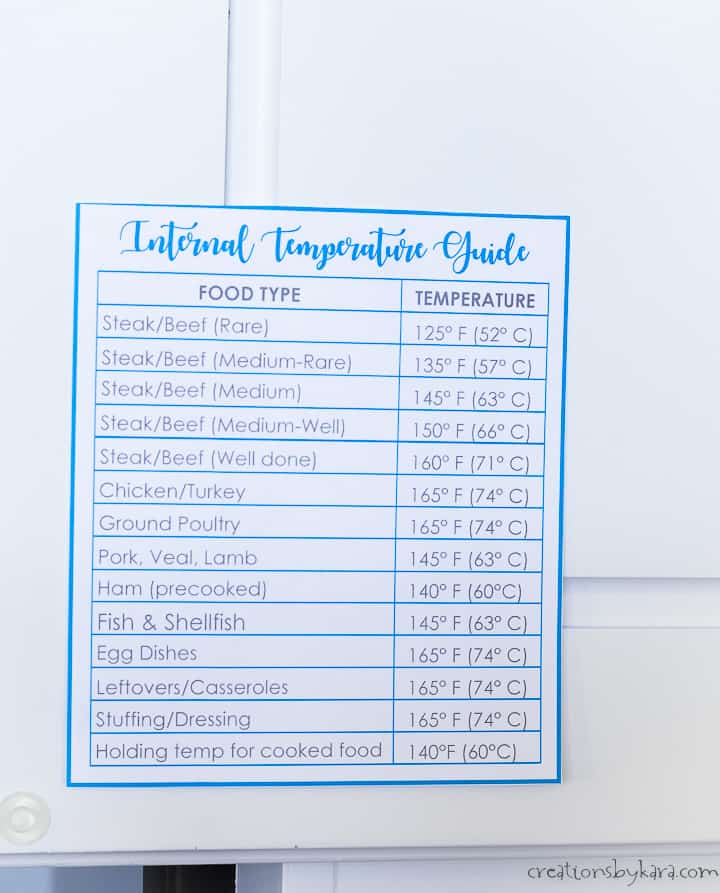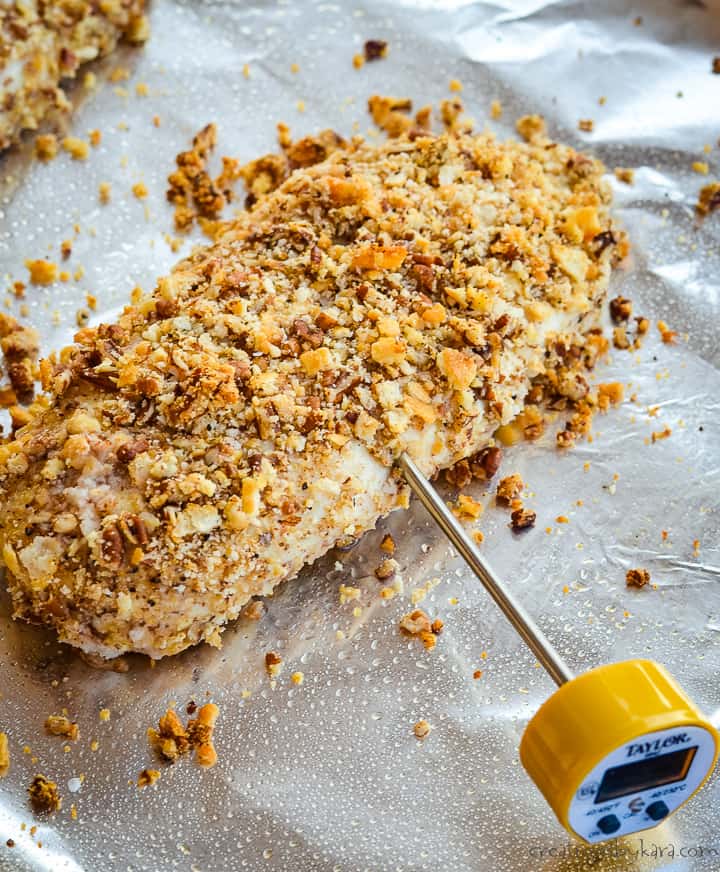Save yourself some hassle and print out this meat cooking temperatures guide before you start cooking dinner! You can even tape it to the inside of a cabinet, or the fridge so that you have the information handy right when you need it.

I’ve cooked enough boneless, skinless chicken breast over the last few decades to know that the internal temp of cooked chicken needs to be 165 degrees. But when it comes to pork and steak, I was always having to check the internet to see the safe meat cooking temperatures.
I decided it was high time I whipped up a meat cooking temperature chart so I could have the information at my fingertips right when I needed it. I’ve got it taped to the inside of the cabinet in between my stovetop and oven range, so when I’m cooking meat it’s right there at eye level. So handy!
WHY MUST MEAT BE COOKED TO ITS MINIMUM INTERNAL TEMPERATURE?
You may be wondering why we even need to check the temperature of cooked meat before we eat it. It’s simple – bacteria. All meat products can naturally have bacteria such as E.coli and salmonella, but they can also come in contact with other types of bacteria during meat processing and handling.
Freezing doesn’t kill many of the strains of bacteria, it can only be destroyed by heat. So cooking your meat to the temperature recommended by the USDA is one way to ensure that you are killing harmful bacteria and preventing foodborne illness.
| TYPE OF MEAT | INTERNAL TEMPERATURE |
|---|---|
| Beef, veal, lamb | 145° |
| Poultry | 165° |
| Pork (roast, chops, etc.) | 145° |
| Precooked ham | 140° (165° if not USDA inspected) |
| Fish | 145° (or until opaque & flakes easily) |
| Ground beef, chicken, pork | 160° |
HOW TO USE A MEAT THERMOMETER
There are many types of meat thermometers – from basic dial type thermometers to thermometers that you can sync with your phone. I prefer instant read digital thermometers because they are more accurate than the dial (or gauge) types, and I don’t need all the bells and whistles of the fancy ones.
Whatever type of meat thermometer you are using, the goal is to find out the temperature in the center of the meat to insure that the internal temperature is high enough. So you need to push the thermometer tip into the thickest part of the meat, making sure you avoid bones and fat.
Follow the directions on your meat thermometer, but most recommend that you stick the thermometer at least two inches into the meat you are cooking. So for thin meats like steak, pork chops, and boneless chicken breast, you need to insert the thermometer into the side of the meat.
After inserting the thermometer wait a few seconds till it is finished reading the temperature. It’s better to check early and have to add more cook time instead of waiting until your meat is overcooked.
TIP: Make sure you let your meat sit for at least 3-5 minutes before you cut into it. Rest time will allow it to re-absorb any liquid it released while cooking, making sure your meat is nice and juicy. If you cut into it too soon, all that juice will leak out, and you will end up with dry meat.
Worried that your meat will cool off too much? Cover it loosely with aluminum foil.
MORE TIPS FOR SAFELY PREPARING MEAT
- Use meat before it expires: You can’t always tell if a cut of meat has gone bad just by looking at or smelling it. It’s best to use it by the expiration date on the label. If you know you won’t be able to use it in time, freeze it!
- Avoid cross contamination: Thoroughly clean any surface that raw meat has come in contact with. I only use plastic cutting boards for meat, because they are dishwasher safe. Also make sure you wash knives and thermometers if they have touched raw meat. (And of course wash your hands with soap and water every time you touch raw meat.)
- Thaw frozen meat safely: It is best to let frozen meat thaw in the refrigerator for a day or two. You can also keep it in it’s wrapper and place it in cold water to thaw. Microwave defrosting is also safe. Thawing meat on the counter at room temperature is NOT recommended by the USDA.
- Keep it cold: After purchasing meat, get it into your refrigerator or freezer as quickly as you can. That goes for leftovers as well. When the meal is over, place your leftovers in the fridge. The USDA recommends that after two hours at room temperature, leftovers should be discarded.
These recommendations come straight from the USDA website, where you can find even more tips and information. I learned a few things while reading all of the guidelines. Truth be told, I do a great job at tossing old meat, and I’m probably too obsessive about washing surfaces and hands.
I’m pretty good at getting leftovers in the fridge within two hours. But I’ve been thawing meat on the counter for years, so I need to be better at that one! 
MEAT COOKING TEMPERATURES CHART
TASTY CHICKEN RECIPES:
- Dijon Chicken
- Italian Chicken Pasta
- Lime Chicken
- Mayonnaise Baked Chicken
- Chicken Parmesan (easy)
- Monterey Chicken
- Baked Chicken Strips




This is perfect!! Meat can be scary, if you don’t cook it right! Keeping this by the fridge!
Thank you so much for this, it’s exactly what I have been looking for. I sent it to my husband too!
This is so so helpful! I have several of these printed out and posted around the house, In the kitchen, by the grill, and in the Airbnb. So awesome to have these to reference. Thanks so much for posting!